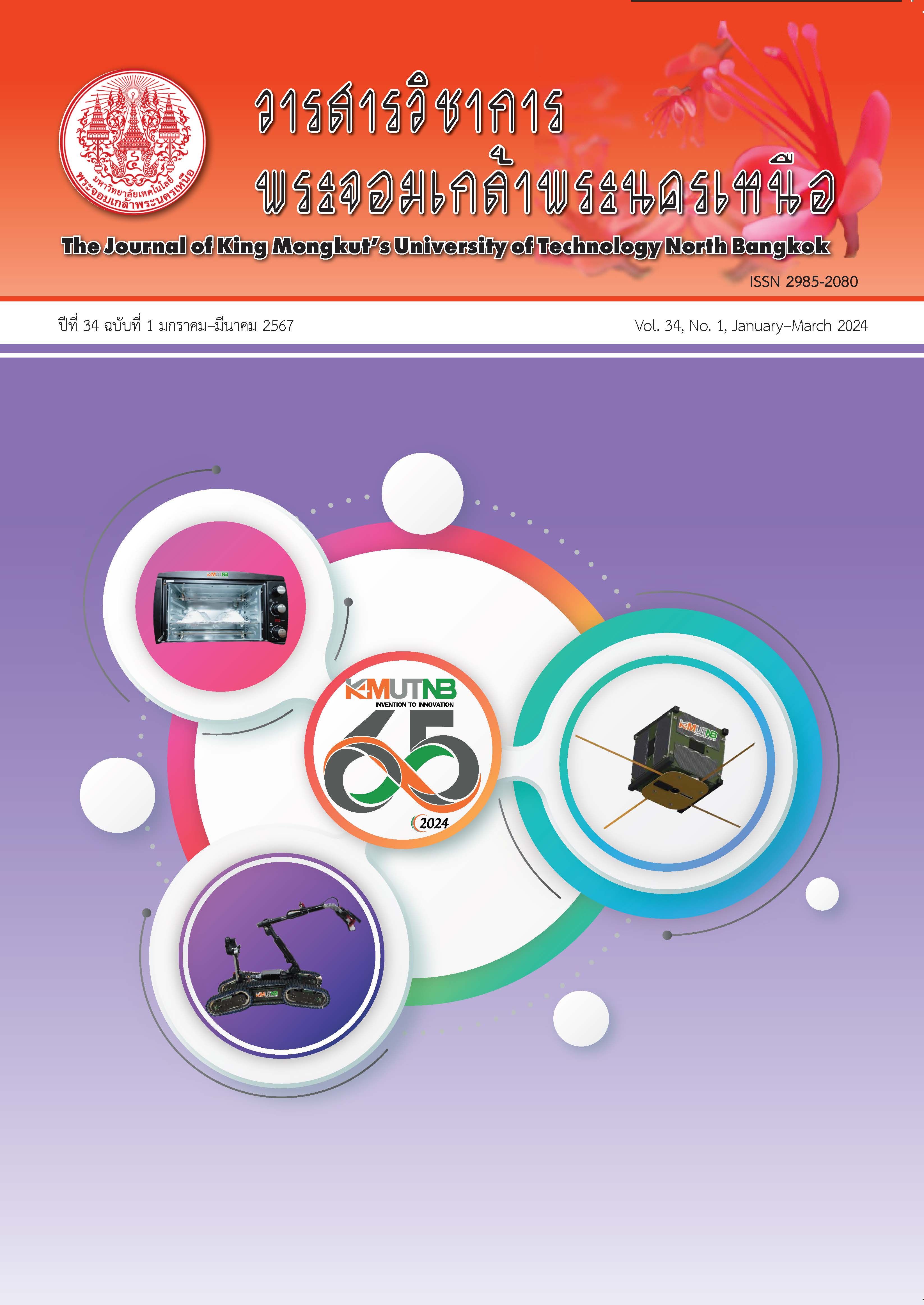การใช้ขยะพลาสติกพอลิเอทิลีนและพอลิโพรพิลีนแทนที่มวลรวมละเอียดบางส่วนในการออกแบบผิวทางแอสฟัลต์คอนกรีต
Main Article Content
บทคัดย่อ
งานวิจัยนี้ศึกษาการใช้ขยะพลาสติกพอลิเอทิลีนและพอลิโพรพิลีนแทนที่มวลรวมละเอียดบางส่วนในการออกแบบผิวทางแอสฟัลต์คอนกรีต โดยใช้มวลรวมหินปูนจำนวน 1 แหล่ง ขยะพลาสติกทั้งสองชนิด (Plastic Waste, PW) ผสมกัน คือ พอลิเอทิลีน (PE) และพอลิโพรพิลีน (PP) ร้อยละเท่ากับ 70:30 ส่วนผสมมี 2 กลุ่มคือ กลุ่มแรก เป็นส่วนผสมแอสฟัลต์คอนกรีต (Asphalt Concrete; AC) อัตราส่วนผสมมวลรวมของยุ้งหินร้อน (Hot Bin Mix Proportion 1:2:3:4) เท่ากับ 48:14:20:18 โดยมวลของมวลรวม และกลุ่มที่สอง เป็นส่วนผสมแอสฟัลต์คอนกรีตผสมขยะพลาสติก (Plastic Waste Asphalt Concrete; PWAC) อัตราส่วนผสมขยะพลาสติกผสมมวลรวมของยุ้งหินร้อน (Hot Bin Mix Proportion PW:1:2:3:4) เท่ากับ 0.3:47.7:14:20:18 โดยมวลของมวลรวม และใช้ปริมาณแอสฟัลต์ซีเมนต์เกรด AC 60-70 เท่ากับ ร้อยละ 5.0 โดยมวลของมวลรวม ทั้งในห้องปฏิบัติการและแปลงทดลอง การเตรียมก้อนตัวอย่างเป็นกระบวนการผสมแบบแห้ง โดยใช้วิธีมาร์แชลล์และเกณฑ์ชั้น Wearing Course ขนาด 12.5 มิลลิเมตร ทดสอบสมบัติด้านความหนาแน่น เสถียรภาพ ค่าการไหล ช่องว่างอากาศ ช่องว่างระหว่างมวลรวม ช่องว่างที่ถูกแทนที่ด้วยแอสฟัลต์ และดัชนีความแข็งแรง พบว่า ปริมาณขยะพลาสติกที่เหมาะสมร้อยละเท่ากับ 70:30 อัตราส่วนผสมมวลรวมของยุ้งหินร้อนและอัตราส่วนผสมขยะพลาสติกผสมมวลรวมของยุ้งหินร้อนทั้งในห้องปฏิบัติการและแปลงทดลองมีสมบัติดังกล่าวอยู่ในเกณฑ์ตามมาตรฐานของกรมทางหลวง
Article Details

อนุญาตภายใต้เงื่อนไข Creative Commons Attribution-NonCommercial-NoDerivatives 4.0 International License.
บทความที่ลงตีพิมพ์เป็นข้อคิดเห็นของผู้เขียนเท่านั้น
ผู้เขียนจะต้องเป็นผู้รับผิดชอบต่อผลทางกฎหมายใดๆ ที่อาจเกิดขึ้นจากบทความนั้น
เอกสารอ้างอิง
Renewable Resources Accounting Handbook, Department of Primary Industries and Mines, Household Group, n.p., 2013.
Bangkokbiznews. (2021, May). So sad Covid poisoning causes plastic waste to overflow the city. [Online] (in Thai). Available: https:// www.bangkokbiznews.com/social/939188
Bangkokbiznews. (2018, December). Plastic waste, global problems. [Online] (in Thai). Available: https://www.bangkokbiznews.com/news/ detail/820466
The Secretariat of the Council of Ministers, “The propulsion mechanism of abstinence using plastic bags,” n.p., 2019.
A. Sultana and K. S. B. Prasad, “Utilization of waste plastic and rigid pavements,” International Journal of Engineering Research and Applications, vol. 2, no. 4, 2012.
T. B. Moghaddam, M. R. Karim, and M. Solthani, “Utilization of waste plastic bottles in asphalt mixture,” Journal of Engineering Science and Technology, vol. 8, no. 3, pp. 264–271, 2013.
H. Jan, M. Y. Aman, S. Khan, and F. Karim, “Performance of hot asphalt mixtures containing plastic bottles as additive,” in Proceeding ISCEE, 2016, pp. 1–7.
A. O. Sojobi, S. E. Nwobodo, and O. J. Aladgegboye, “Recycling of polyethylene terephthalate (PET) plastic bottle wastes in bituminous asphaltic concrete,” Cogent Engineering, vol. 3, no. 1, Article. 1133480 , 2016.
W. Jongjit, O. Somchinuek, and C. Thipakornkiat, “Asphaltic concrete pavement using recycled material,” in Proceeding NCCE, 2017, pp. 1–9 (in Thai).
W. Lakas, W. Setthapun, and K. Lucksiri, “Process of asphaltic concrete pavement construction to reduce plastic waste problems in the community,” Academic Journal Uttaradit University, vol. 12, no. 1, pp. 41–53, 2017 (in Thai).
A. F. Ahmad, A. R. Razali, and I. S. Razelan, “Utilization of polyethylene terephthalate (PET) in asphalt pavement,” in Proceeding IOP, 2017, pp. 1–7.
S. S. Ali, N. Ijaz, N. Aman, and E. Noor, “Feasibility study of low density waste plastic in non-load bearing asphalt pavement in district faisalabed,” Earth Sciences Pakistan, vol. 1, no. 2, pp. 17–18, 2017.
A. Awad, and F. A. Adday, “Utilization of waste plastics to enhance the performance of modified hot mix asphalt,” International Journal of GEOMATE, vol. 13, no. 40, pp. 132–139, 2017.
P. Chuensiri, and N. Nokkaew, “Engineering properties of asphalt concrete mixed with polyethylene plastic waste,” The Journal of KMUTNB, vol. 32, no. 3, 2022 (in Thai).
Guidelines for The Use of Waste Plastic in Hot Bituminous Mixes (Dry Process) in Wearing Courses, 1st Ed., Indian Roads Congress, Delhi, 2014, pp. 1–13.
N. Nokkaew, Highway Materials Testing, Bangkok: Technology Promotion Association (Thailand-Japan), 2016.
Technologychaoban. (2021, March). TISTR joins hands with partners to transfer knowledge on community waste management and adding value. [Online] (in Thai). Available: http:// www.technologychaoban.com/uncategorized/ article_174100
Bureau of Materials, Research and Development, “Standard test methods,” Express Transportation Organization of Thailand, Bangkok, Thailand, 2000, pp. 94–184.
Bureau of Materials, Research and Development, “Standards for highway construction,” The Agricultured Co-operative Federation of Thailand., Ltd., Bangkok, Thailand, 1996, pp. 263–312.

